There are many reasons why we keep aquarium plants, like keeping our water chemistry balanced and increasing the aesthetic value of our aquarium.
Another reason is that they can hide things or objects we don’t want to see, such as the substrate. After all, the substrate is lifeless, and our attention is focused mainly on living organisms like plants and fish.
If you want to hide your substrate in exchange for vibrant greenery that is full of life, then consider having the Dwarf Hairgrass.
In this article, we will outline all the significant information you need to know about taking care of this carpeting plant.
Biological Characteristics
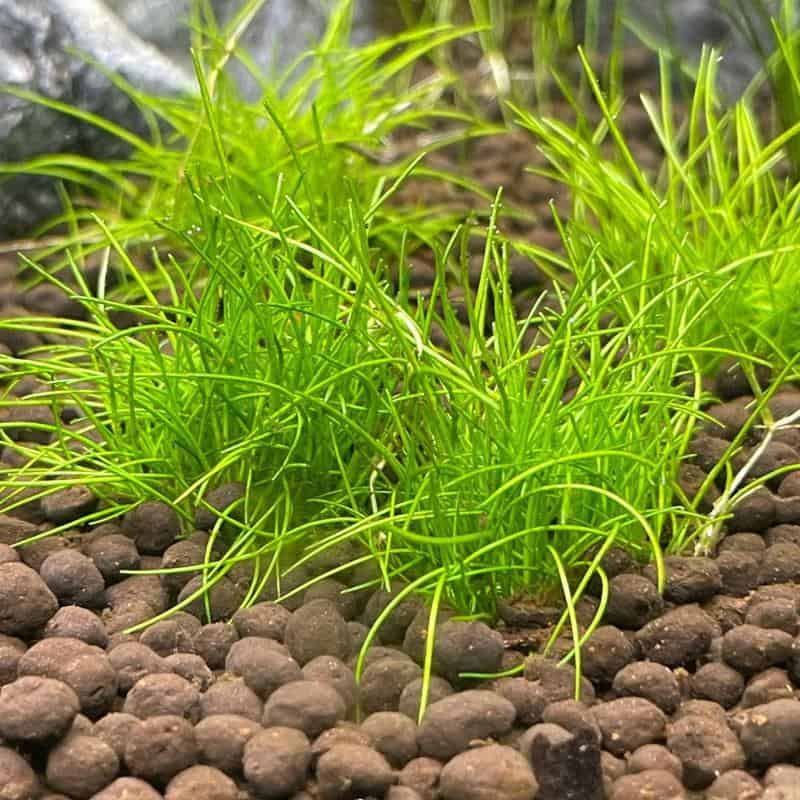
Of all the aquarium plants, the Dwarf Hairgrass is one of the easiest to identify. This is due to their grass-like appearance and how their growth carpets along the substrate.
Origins
Dwarf Hairgrass naturally occurs around the world’s freshwater ecosystems. From the Americas to Europe and Asia, they can live in tropical, subtropical, or temperate conditions, making them highly versatile and adaptive to a wide range of parameters.
While they thrive across the globe, what is common to their freshwater habitat is the shallowness and the unobstructed exposure to sunlight.
Blade-Shaped Leaves
The leaves of Dwarf Hairgrass are not the typical round or oval shape as most aquarium plants have. Instead, their leaves are thin, blade-like, and grow vertically, pointing towards the surface.
Dwarf Hairgrass are not column feeders. They use their leaf blades primarily for photosynthetic activity and not for absorbing nutrients directly in the water column.
As their leaf blades develop and grow taller, they can sway, especially when there is a water current. Aside from being aesthetically pleasing to our eyes, the swaying of their leaf blades sparks interest in your tank residents, and they tend to play along or hide beneath their strands.
When they grow, Dwarf Hairgrass will create dense matting covering the substrate with grassy greenery.
Deep Root-Feeding Plants
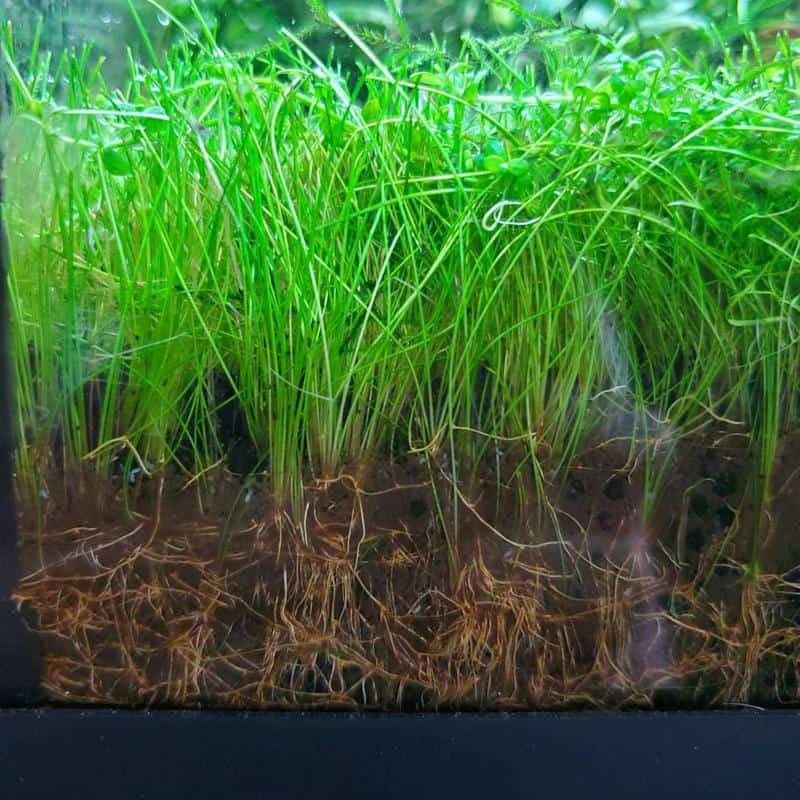
The roots of a Dwarf Hairgrass are colored white. In the wild, their root system is buried deep in the substrate. It supports their vertical growth while anchoring the plant in place, especially when their leaf blades start swaying.
Another importance of their root system is their nutrient absorption ability. Being a root feeder, the roots of a Dwarf Hairgrass absorb nutrients directly in the substrate. It is why you need to nourish it with fertilizers (to be discussed in the later section).
Runners and Their Carpeting Growth
Being a carpeting plant, the growth of Dwarf Hairgrass is primarily horizontal spreading. They do this by sending out slender stems called runners, which give rise to new roots, stems, and leaves.
Their runners are highly prolific and fast spreaders, allowing the plant to grow 1 to 2 inches weekly. In my case, the Dwarf Hairgrass was able to carpet my 20-gallon tank in just a month.
Benefits in The Tank
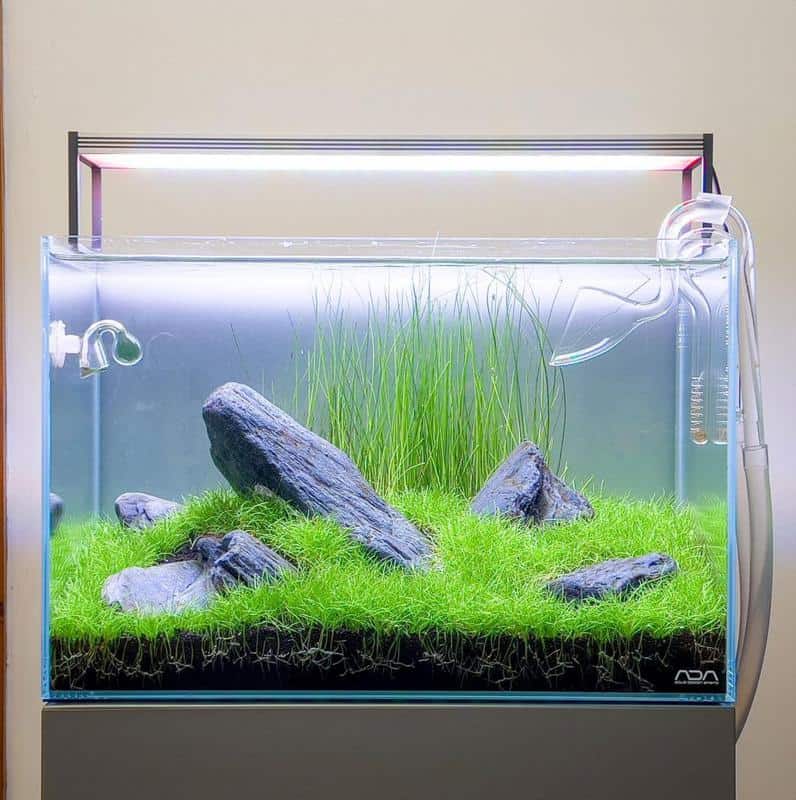
Increased aesthetics and covering the substrate are not just the benefits Dwarf Hairgrass gives to your tank. They have biochemical benefits that we don’t see with our naked eye, like water oxygenation and the removal of excess nutrients.
When they are fully grown and carpeted most of the substrate, the Dwarf Hairgrass will also become a refuge for bottom dwelling organisms.
Two Closely Related Species
For the untrained eye and newbie aquarists, all Dwarf Hairgrass may look the same. But taxonomically, there are two species of Dwarf Hairgrass commonly sold in the aquarium industry, namely: Eleocharis parvula and Eleocharis acicularis.
Here’s a quick comparison between the two species of Dwarf Hairgrass.
| E. parvula | E. acicularis | |
| Blade height | Shorter (3 in) | Taller (8 in) |
| Blade thickness | Thicker | Thinner |
| Blade shape | Wavy | Straight |
| Blade color | Dark green | Light green |
| Growth rate | Faster | Slower |
Planting Procedure
Dwarf Hairgrass is a popular aquarium plant, and they are readily available in pet shops. Commonly, they are sold in groups of several shoots called tuft.
Division of Tuft Into Segments
Once you have a tuft, do not directly plant them in the substrate. Instead, place them in a container filled with water. Slowly separate and scatter them until the tuft is reduced and divided into smaller segments (10 to 15 shoots per segment).
Depending on the size of the tuft, you should be able to produce 15 to 20 segments for planting.
Pre-Planting Inspection
Before planting each segment, check the health of each shoot. Take out unhealthy or damaged parts like brown discoloration, dark patches, and torn leaf blades.
A healthy shoot should have long roots and leaves that are complete and vibrantly green in color. Never plant unhealthy Dwarf Hairgrass since they will have difficulty adjusting to their new environment.
Full Root Burial
After dividing the tuft into smaller segments and checking them for damage, it is time to plant them in your aquarium.
Using an aquarium tweezer, pick a segment and plant them directly in the substrate. Make sure you bury their entire root system, and only their leaf blades are above the substrate and exposed in the water column.
Spacing
Since Dwarf Hairgrass grows fast, you should practice spacing between segments (2 to 3 inches). In this way, you allow all the shoots to be directly exposed to light and maximize their photosynthetic activity.
Clumping them all together in a single spot in your tank defeats the purpose of dividing the tuft into segments. It will also place some shoots under the shade. Remember that their leaf blades will only photosynthesize under direct light.
The bigger the spacing, the better photosynthetic activity in their leaf blades.
Growth Requirements
The Dwarf Hairgrass has a wide range of natural habitats. But despite this, you need to meet their growth requirements for optimal plant development.
Sandy Gravel Substrate
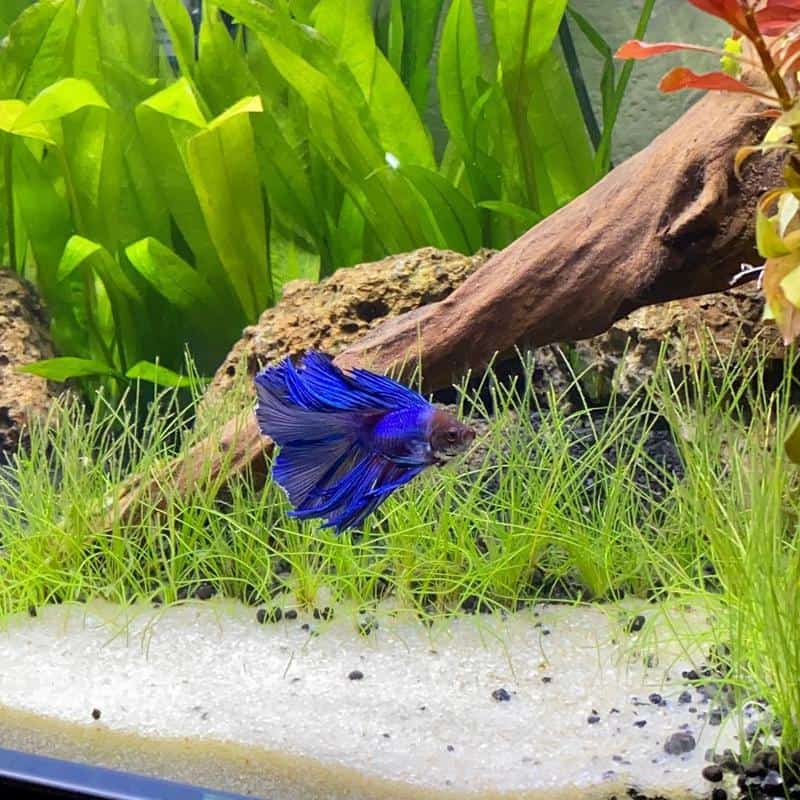
Of all their required growth parameters, we would like to focus on their substrate requirement since this is the very foundation that will support plant growth.
Sand is the ideal substrate for growing Dwarf Hairgrass. With their soft texture, their roots can penetrate and spread out. However, as the plant grows vertically, sand alone may not be solid enough to support its weight. It is why most aquarists mix sand with gravel.
Another thing that we would like to highlight with their substrate is the thickness. Since their roots need to be buried completely, you must provide a thick substrate anywhere from 2 to 3 inches deep.
Fertilizer Supplements
Dwarf Hairgrass can grow without fertilizers. However, applying some supplements will generally increase its growth, improve its health condition and intensify its vibrant greenery.
While you can apply liquid fertilizers, we recommend you use root tabs. Remember that Dwarf Hairgrass are root-feeders, and the root tabs will enrich your substrate with their much needed nutrients.
Most of the root tabs available in the market contain nitrogen, potassium, and phosphorus, all of which can boost Dwarf Hairgrass growth.
Similarly, you can consider applying carbon dioxide (either in liquid or gas form). It will enhance the green coloration and growth of your Dwarf Hairgrass while increasing its photosynthetic efficiency.
After planting, you can add a small amount of carbon dioxide to boost their acclimation process. After which, add moderate amounts to maintain steady growth.
Water Parameters
Even if the Dwarf Hairgrass can thrive in a wide range of habitats, you must maintain its water parameters, especially in a closed environment like your tank.
Here is a compiled list of parameters in keeping Dwarf Hairgrass.
| Parameters | Range |
| Substrate | Sandy – Gravel |
| Light | Moderate to High |
| Water flow | Low to Moderate |
| Temperature | 10 – 29 C (50 to 85 F) |
| pH | 6.5 – 7.5 |
| Hardness | 2 – 10 |
| Fertilizers | Low to Medium |
| CO2 | Low to Medium |
Pruning Procedure
What do you do when your garden grass is tall and overcrowded? You start your lawn mower and trim the grass until they are neatly clean.
Same with Dwarf Hairgrass, you need to trim when they are tall, become overcrowded, and more shoots are shaded reducing their photosynthetic activity.
Unfortunately, aquarium lawn mowers have not yet been invented. Trimming your Dwarf Hairgrass is always done old school using a pair of scissors.
Flat Grass
The easiest trimming method you can do to your Dwarf Hairgrass is cutting them in such a way that the shoots collectively make a flat surface altogether.
When it comes to height, there is no recommended height level. It depends on how tall or short you want your Dwarf Hairgrass to be. Just do not cut them all the way from where they sprout.
Also, make sure that you retrieve all the cuttings out of the tank as this may degrade and spoil over time. As they degrade, they emit chemicals that can disrupt your water chemistry.
Sloping Grass
Leveling up your landscaping skills, you can add dimension to your Dwarf Hairgrass. You can do this by trimming the front plants shorter and taller at the back.
After which, you can make sloping grass that greatly adds more aesthetic beauty. From the taller plants at the back, cut down with an angle towards the shorter plants at the front.
Again, do not forget to collect and retrieve all the cuttings.
Grass Terraces
A multi-layered Dwarf Hairgrass is one of the most appreciated planted tanks. You can do this to your aquarium by cutting the back plants to the tallest, the mid plants to medium height, and the front plants to the shortest.
Similarly, you can add rocks or driftwood for a more layering effect.
Methods of Propagation
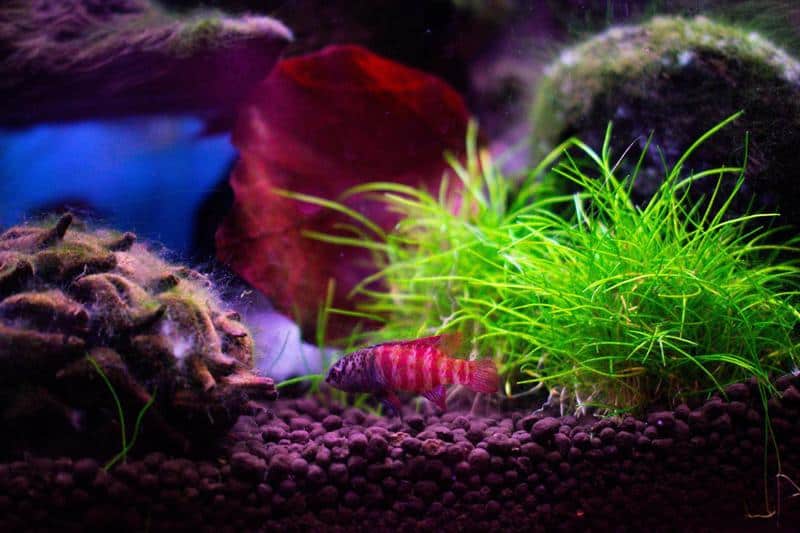
If you are thinking of using the cuttings and planting them elsewhere, please don’t. Propagation through cuttings will not work with Dwarf Hairgrass since they will not produce roots.
Cutting Runners for Tuft
Sending out runners is the easiest and fastest way a Dwarf Hairgrass propagates.
From your tank with fully matured Dwarf Hairgrass, select a healthy group of shoots, cut their runners on the edge, and uproot them as a whole to form a tuft.
The tuft will become your base material in planting new-generation Dwarf Hairgrass in another tank. Similarly, if you are considering business, you can sell your tuft and earn some money to expand your aquarium hobby.
Propagation from Seeds
The base material for planting Dwarf Hairgrass does not always come from tufts. You have the option to propagate them from seeds and this is best done if you are setting up a new tank.
Once you pour the substrate in the tank, sprinkle a small amount of water to moisture and prepare the top layer for seeding. From your seed package, sprinkle the seeds over the substrate and cover the tank with a lid.
It will take 7 to 15 days for the seeds to germinate and almost a month for the shoots to sprung out. After which, add water to your tank until your desired level.
If you don’t have a separate aquarium for seed propagation, you can utilize used small containers (great for recycling plastics).
Read More:
FAQs
What Is the Minimum Tank Size for Dwarf Hairgrass?
Dwarf Hairgrass are versatile plants, and as long as you provide all their growth parameters, they can grow even in small tanks. The fact is, they were recorded to successfully grow in a 3-gallon fish tank with betta fish as its tank mate.
However, you will not appreciate their carpeting effect if they are kept in a small container. It is why a 10-gallon tank is recommended as the minimum tank size for keeping Dwarf Hairgrass which allows the plant to grow and bloom to its full potential.
What Are Some Great Tank Mates for Dwarf Hairgrass?
Dwarf Hairgrass is one of the many aquarium plants compatible with several fish and other tank residents.
Being a carpeting plant, they are perfect for small and bottom-dwelling fish like Zebra Loaches, Mollies, Bettas, Neon Tetras, Guppies, and Danios.
And not just fish, invertebrates (like shrimps and snails) will greatly benefit from the refuge provided by Dwarf Hairgrass.
What Are the Worst Tank Mates for Dwarf Hairgrass?
Any fish with a nuisance and boisterous behavior is incompatible with Dwarf Hairgrass. Some of the worst tank mates for Dwarf Hairgrass include Oscars and Cichlids, where the incidence of uprooting while searching for food is common.
What Is the Lifespan of Dwarf Hairgrass?
If taken care of, Dwarf Hairgrass can live for up to 2 years. But this is not bad since most aquarium plants can live for 5 years on average.
Final Words
Reading up to this point will give you the impression that there is a lot to do in keeping Dwarf Hairgrass. Truly, there is a lot to do with this plant, especially if you’re considering them for aquascaping.
It will also give you the impression that Dwarf Hairgrass are only for experienced aquarists. I beg to disagree since they are ideal for newbies. The fact is, this was one of my early plants when I started the hobby.
And with my experience gained from keeping Dwarf Hairgrass, it leveled me up in handling more challenging aquarium plants.